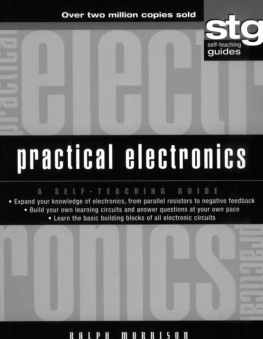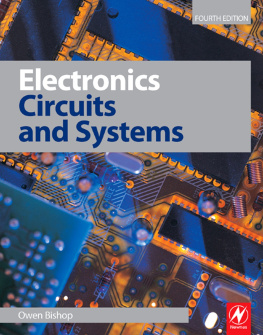Chapter 1. Analog Versus Digital
It was a dark and stormy night
Ah, the classic opening: It was a dark and stormy night which was made famous by the Peanuts cartoon character, Snoopy (see Box). I always wanted to start a book this way myself, and this is as good a time as any
The phrase It was a dark and stormy night is actually the opening sentence of an 1830 book by the British author Edward George Earl Bulwer-Lytton. A legend in his own lunchtime, Bulwer-Lytton became renowned for penning exceptionally bad prose, of which the opening to his book Paul Clifford set the standard for others to follow.
For your delectation and delight, the complete opening sentence of Bulwer-Lyttons masterpiece was: It was a dark and stormy night; the rain fell in torrentsexcept at occasional intervals, when it was checked by a violent gust of wind which swept up the streets (for it is in London that our scene lies), rattling along the housetops, and fiercely agitating the scanty flame of the lamps that struggled against the darkness.
Actually, Bulwer-Lytton (18031873) was a very popular writer in his day, coining such phrases as the great unwashed, pursuit of the almighty dollar, and the pen is mightier than the sword. However, he may well have fallen into obscurity along with so many of his contemporaries if it were not for the annual Bulwer-Lytton Fiction Contest sponsored by the English Department of San Jose State University.
It was a dark and stormy night is now generally understood to represent an extravagantly florid style with redundancies and run-on sentences, and the Bulwer-Lytton Fiction Contest was formed to celebrate the worst extremes of this general style of writing. Over the years, the contest has gained international attention and now attracts 10,000 or more entries a year. In fact, I myself have submitted an entry for the 2008 competition, but all Ive heard so far is an e-mail message saying that I can be assured that my offering will be given the consideration it deserves. On the off-chance that youre interested, Ive included a copy of my humble submission at the end of this chapter.
Analog versus digital views of the world
] and digital, and its necessary to understand the difference between these views to make much sense out of the rest of this book.
In England, analog is spelled analogue, and its pronounced with a really cool accent.
At this point, even though weve barely dipped our toes in the water, I can imagine you rolling your eyes saying to yourself: Good grief, I already know all of this stuff! Well, Im hoping that by the time we reach the end of this first chapter youll be thinking: Hmmm, maybe Max is not as daft as he looks (but, there again, who could be?) I actually learned something here. I cant wait to read the next chapter. And just as soon as I get a spare moment I will rush out and buy some of Maxs other books!
In the context of electronics, an analog device or system is one that uses continuously variable signals to represent information for input, processing, output, and so forth. A very simple example of an analog system would be a light controlled by a dimmer switch.
]
At least, thats the way they work in America. Its the opposite way round in England, and you take your chances in the rest of the world.
). Time is considered to progress from left to right, and the solid lineswhich engineers often refer to as waveformsindicate what is happening.
Figure 1.1. Digital versus analog waveforms.
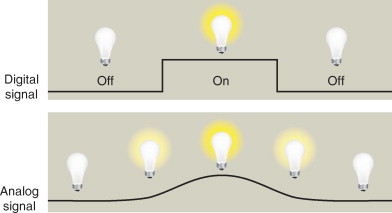
In this illustration, the digital waveform commences in its off state. After some time it changes to its on state, and sometime later it returns to its off state. By comparison, in the case of the analog waveform, we typically dont think in terms of on and off. Rather, we tend to regard things as being more on or more off with an infinite number of values between these two extremes.
Multi-value digital systems
).
Figure 1.2. Staircase and ramp.

In order to accurately determine this persons position on the ramp, an independent observer would require the use of a tape measure. (Of course, everyone involved would have to be in agreement as to the specific end points being measured, such as the tip of the ramp-sliders nose or his belly button, for example.) The exact position on the ramp, as measured using the tape measure, would be considered to be an analog value. In this case, the analog value most closely represents the real world and can be as precise as the measuring technique allows.
Alternatively, an observer could estimate the ramp-sliders approximate location in relation to the nearest stair. Such an estimation would be considered to be a digital value.
).
Figure 1.3. Waveforms showing the ramp-sliders position.
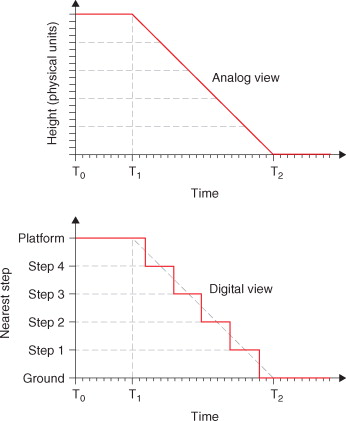
Once again, the horizontal axis in both waveforms represents the passage of time, which is considered to progress from left to right. In the case of the analog waveform, the vertical axis is used to represent our thrill-seekers exact location in terms of height above the ground, and is therefore annotated with real, physical units. By comparison, the vertical axis for the digital waveform is annotated with abstract labels, which do not have any units associated with them.
Experiments with bricks
).
Figure 1.4. Brick suspended by elastic.
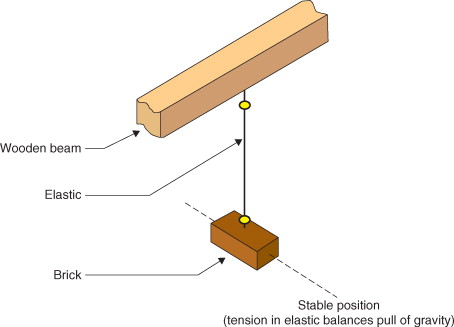
Lets assume that at time t0 the system is in its stable state. The system remains in this state until time t1, when an inquisitive passerby grabs hold of the brick and pulls it down, thereby increasing the tension on the elastic. It takes some amount of time to pull the brick down, and it reaches its lowest point at time t2.
).
Alright, alrightjust after releasing the brick, our passerby walked around a corner and bumped into a beautiful girl. They fell in love, got married, bought a small cottage in the country, had three children (two girls and a boy), and lived happily ever after.
Figure 1.5. Brick on elastic: Analog waveform.
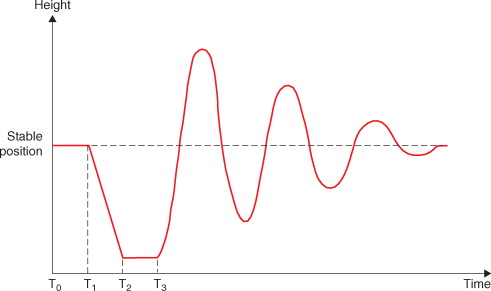
). (Our original analog waveform is shown as a dotted line.)
Figure 1.6. Brick on elastic: Two-quanta digital system.
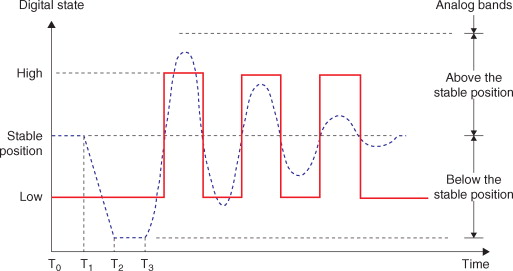
Although it is apparent that the digital view is a subset of the analog view, digital representations often provide extremely useful approximations of the real world. If the only requirement in the above example is to determine whether the brick is above or below the stable position, for example, then the digital view is the most appropriate.

![Clive Maxfield [Clive Maxfield] Bebop to the Boolean Boogie, 3rd Edition](/uploads/posts/book/124140/thumbs/clive-maxfield-clive-maxfield-bebop-to-the.jpg)







